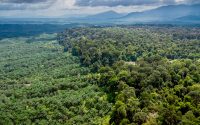After Devastating Floods, Vermont Is Open and Welcoming Tourists for Fall
On a recent afternoon Susan Allen gazed at a sun-soaked hillside cloaked in a rich autumn palette of red, gold, purple and green. The retiree from Lebanon, Ky., sat licking her lips after savoring a syrup-dipped pickle at the Morse Farm Maple Sugarworks in Montpelier, Vt., a popular stop on central Vermont’s leaf-peeping circuit.
“I love it,” she said of the pickle and the place. “The weather’s been beautiful. The scenery is gorgeous.”
Her traveling companion nodded in agreement. The two of them had heard about floods that devastated parts of the state this summer but, Ms. Allen said, they had not seen any sign of the disaster. Instead, they were in thrall of the farm’s brilliant foliage and maple ice cream, maple fudge, maple kettle corn and, well, maple everything. Jake Shattuck, the Morse Farm owner, said his property was unscathed by the water, and quipped that Vermont “is 98 percent open.”
That wasn’t the case in downtown Montpelier, just three miles away. When record rain fell in July, causing the dangerous flooding, two deaths, millions of dollars in damage and hundreds of rescue missions across the state, Montpelier’s vibrant downtown of shops, restaurants and state offices was transformed into a muddy wasteland. Montpelier, the capital of Vermont, was one of the hardest hit cities in an extreme weather event Gov. Phil Scott described as “historic and catastrophic.”
On Oct. 6, Montpelier threw a street party and celebrated the reopening of a handful of businesses but the city’s largest hotel, the Capitol Plaza, remains shuttered. Most of the town swirls with construction dust and reverberates with the din of power tools as downtown businesses labor to reopen by the end of the year.
In early September, Vermont tourism officials launched a $200,000 marketing campaign proclaiming the state “Very Much Open.” The goal is to reassure visitors that Vermont is ready to welcome them, not only the two million visitors who come every year to see Vermont’s famous display of fall foliage, but also the more than three million skiers who follow.
As the marquee on one of Montpelier’s movie theaters wryly announced in black lettering, “We will be back after a brief intermission.”
The wettest month ever
According to the National Weather Service in Burlington, Vt., up to two feet of rain fell on Central and Southern Vermont from June through August, making 2023 the wettest summer on record for the state. Over a foot of rain fell in Montpelier in July, its wettest month ever.
On July 10, five inches of rain fell in Montpelier. Water poured down city streets and turned the downtown business district into a lake. Photos of residents paddling canoes near the golden dome of the Vermont State House were splashed across national newspapers, broadcast news and the internet.
At Bear Pond Books on Main Street, staff had prepared for the worst before the deluge by moving all the books two feet off the ground. They underestimated.
“Much to our horror, it rose to four feet,” recalled Robert Kasow, a co-owner. The store lost 3,000 books, most of its furniture and all its computer records. Some 125 businesses were damaged in Montpelier, a city of 8,000 people.
In Ludlow, Vt., water and rocks flowed down the trails of the Okemo Mountain Resort ski area to the downtown area, destroying homes and businesses. Across the state, some 6,000 people and more than 150 municipalities have applied for disaster assistance from the Federal Emergency Management Agency. Damage is expected to exceed $200 million, comparable to Tropical Storm Irene in 2011.
A toll on tourism
The summer washout took a toll on Vermont’s $3 billion tourism industry. In a typical year, 13 million people flock to the small state of 647,000 people to enjoy hiking, biking, leaf peeping and skiing. This year, summer tourism was down 10 to 15 percent, but dropped as much as 50 to 90 percent in the weeks after the flood in the small number of towns that experienced severe flooding.
“In the aftermath of the flooding, there were a lot of questions and concerns in the public in terms of whether Vermont was ready for visitors to come back or not,” said Heather Pelham, commissioner of Vermont’s tourism and marketing agency. The goal of the “Very Much Open” campaign is “to encourage visitors to come back so that they could see that they were really as much a part of our recovery as residents.”
Vermont is world renowned for its vivid fall foliage. “We have a great mix of species in our forests that result in a diversity of colors on the landscape: Yellows from birches, oranges from sugar maples, scarlet reds from red maples and darker reds from species like oaks and ash,” said Josh Halman, forest health program manager with the Vermont Department of Forests, Parks and Recreation. “Having hills and mountains where folks can see this diversity in many locations helps too.”
But leaf peeping, which contributes around $600 million to Vermont’s economy, is facing multiple challenges, including Canadian wildfires, record-breaking rain and climate change. This year’s damp summer contributed to the spread of leaf disease that caused some leaves to have black spots and drop early.
Compared to years past, “our falls are getting warmer with climate change and generally this is leading to the onset of fall foliage later,” said William S. Keeton, professor of forest ecology and forestry at the University of Vermont. The warm temperatures “might mean that trees maintain their greenness longer with less vibrancy of colors. Or it happens a little later. Or it’s for a shorter time period. Or maybe a little bit less brilliant.”
“Vermont has the most spectacular fall foliage in the world,” Dr. Keeton said. But pinpointing the mythical moment of “peak foliage” is getting harder to predict.
“Each year the great reveal of color is a bit of a mystery right up until the end,” he said.
Leaf peeping after the deluge
Despite damage in some localities, most of Vermont was unaffected by flooding. Fall foliage hotel occupancy levels in Stowe are at an all-time high, said Carrie Simmons, executive director of the Stowe Area Association, a nonprofit tourism agency.
“Stowe is one of the best places for leaf peeping in the country,” she said. As the town’s October traffic jams might indicate, many visitors agree.
About two hours south, in Weston, Vt., visitors crowded the narrow aisles at the Vermont Country Store on a brilliant October day. Well-worn wooden floorboards creaked underfoot in the family-owned store that dates to 1946. The racks were crammed with “the practical and hard to find,” including checkered flannel, cheese, maple treats, locally made Darn Tough socks, and all manner of Vermontiana.
Sheena Smith, the store’s director of retail, said that more than a million people visit the store each year, but there has been a roughly 20 percent drop in traffic since the summer floods. Weston and nearby Ludlow were flooded, but the store was not.
“Unfortunately, we still hear it to this day that people think they can’t get here. And then when they do, they’re quite surprised,” she said.
Across the village green, the Weston Playhouse, home to the storied 87-year-old theater company beloved by Broadway actors and its nightly audiences, sits empty. On July 10, the West River poured into the theater’s basement and forced the closure of the playhouse until at least next summer. But the actors improvised, moving their performances across the road, to the company’s smaller theater at Walker Farm. They put on the musical, “Singin’ in the Rain,” and even made it rain — outside, visible from the building’s interior through a raised delivery door.
“We thought it was a little bit too soon to have everybody watch it rain inside the theater,” said Susanna Gellert, executive artistic director of the Weston Theater Company.
On a recent fall day, Ms. Gellert stood outside as tourists photographed the picturesque white theater. “They should be coming back,” she said of the visitors. “There is no more glorious spot than right here, truly.”
Looking ahead is Bruce Schmidt, vice president and general manager of the Okemo ski area. “We’re cleaned up, buttoned up, fixed up, repaired, replaced,” he said. “We will have no problem being ready for the winter.”
The Montpelier bookseller, Robert Kasow, is flood-weary but also hopeful. “The leaves are still beautiful, the parks are still open and beautiful. They just have to be patient with us a little bit until we get our stuff all cleaned up and shiny and ready to go.”
After seven weeks of mucking out and rebuilding, Bear Pond Books reopened in early September.
Follow New York Times Travel on Instagram, Twitter and Facebook. And sign up for our weekly Travel Dispatch newsletter to receive expert tips on traveling smarter and inspiration for your next vacation.


